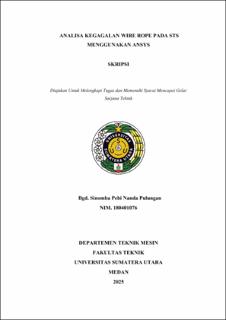| dc.description.abstract | Wire rope is one of the critical components in the lifting system of a Ship to Shore (STS) Crane, functioning to lift and lower container loads. Wire rope failure can lead to total system breakdown, posing safety hazards and operational losses. This study aims to analyze the root causes of wire rope failure using the Root Cause Analysis (RCA) method, calculate the Safe Working Load (SWL), and simulate stress distribution and deformation using ANSYS software with a Static Structural approach. The wire rope used in this study has a diameter of 28 mm, a 6x36 strand configuration, and is made from galvanized high carbon steel. The simulation results show a maximum von Mises stress of 681 MPa, a displacement of 16 cm, and a safety factor of 0.53. The failure location is identified in the outer strand, which is the most stress-concentrated area. SWL calculation indicates that the working capacity of the wire rope is significantly below the crane's lifting load (40 tons), reinforcing the conclusion that the wire rope is operating under overstressed conditions. The study concludes that the wire rope is no longer suitable for continued use under current operational conditions, and recommends maintenance improvements, scheduled replacements, and redesign of support systems. | en_US |


